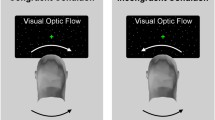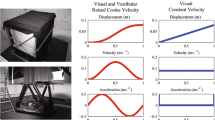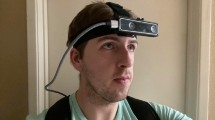Abstract
This article addresses the intersection between perceptual estimates of head motion based on purely vestibular and purely visual sensation, by considering how nonvisual (e.g. vestibular and proprioceptive) sensory signals for head and eye motion can be combined with visual signals available from a single landmark to generate a complete perception of self-motion. In order to do this, mathematical dimensions of sensory signals and perceptual parameterizations of self-motion are evaluated, and equations for the sensory-to-perceptual transition are derived. With constant velocity translation and vision of a single point, it is shown that visual sensation allows only for the externalization, to the frame of reference given by the landmark, of an inertial self-motion estimate from nonvisual signals. However, it is also shown that, with nonzero translational acceleration, use of simple visual signals provides a biologically plausible strategy for integration of inertial acceleration sensation, to recover translational velocity. A dimension argument proves similar results for horizontal flow of any number of discrete visible points. The results provide insight into the convergence of visual and vestibular sensory signals for self-motion and indicate perceptual algorithms by which primitive visual and vestibular signals may be integrated for self-motion perception.
Similar content being viewed by others
References
Banks MS, Ehrlich SM, Backus BT, Crowell JA (1996) Estimating heading during real and simulated eye movements. Vis Res 36(3): 431–443
Barmack NH (2003) Central vestibular system: vestibular nuclei and posterior cerebellum. Brain Res Bull 60: 511–541
Beck JC, Rothnie P, Straka H, Wearne SL, Baker R (2006) Precerebellar hindbrain neurons encoding eye velocity during vestibular and optokinetic behavior in the goldfish. J Neurophysiol 96: 1370–1382
Bertin RJV, Berthoz A (2004) Visuo-vestibular interaction in the reconstruction of travelled trajectories. Exp Brain Res 154: 11–21
Bertin RJV, Israël I, Lappe M (2000) Perception of two-dimensional, simulated ego-motion trajectories from optic flow. Vis Res 40: 2951–2971
Bremmer F, Lappe M (1999) The use of optical velocities for distance discrimination and reproduction during visually simulated self motion. Exp Brain Res 127(1): 33–42
Büttner-Ennever JA, Horn AKE, Graf W, Ugolini G (2002) Modern concepts of brainstem anatomy: from extraocular motoneurons to proprioceptive pathways. Ann NY Acad Sci 956: 75–84
Cutting JE, Vishton PM, Flückiger M, Baumberger B, Gerndt JD (1997) Heading and path information from retinal flow in naturalistic environments. Percept Psychophys 59(3): 426–441
Frenz H, Lappe M (2005) Absolute travel distance from optic flow. Vis Res 45: 1679–1692
Frost BJ, Wylie DR, Wang Y-C (1990) The processing of object and self-motion in the tectofugal and accessory optic pathways of birds. Vis Res 30(11): 1677–1688
Goldberg JM, Fernández C (1984) The vestibular system. In: Brookhart JM, Mountcastle VB, Darian-Smith I (eds) Handbook of physiology—the nervous system III. American Physiological Society, Baltimore, pp 977–1022
Gordon DA (1965) Static and dynamic fields in human space perception. J Opt Soc Am 55: 1296–1303
Guedry FE (1974) Psychophysics of vestibular sensation. In: Kornhuber HH (eds) Handbook of sensory physiology, vol 6. Springer, New York, pp 3–154
Hanes DA, Keller J, McCollum G (2008) Motion parallax contribution to perception of self-motion and depth. Biol Cybern 98(4): 273–293
Harris LR (1994) Visual motion caused by movements of the eye, head, and body. In: Smith AT, Snowden R (eds) Visual detection of motion. Academic Press, London, pp 397–436
Harris LR, Jenkin M, Zikowitz DC (2000) Visual and non-visual cues in the perception of linear self motion. Exp Brain Res 135: 12–21
Holly JE (2000) Baselines for three-dimensional perception of combined linear and angular self-motion with changing rotational axis. J Vestib Res 10: 163–178
Ivanenko YP, Grasso R, Israël I, Berthoz A (1997) The contribution of the otoliths and semicircular canals to the perception of two-dimensional passive whole-body motion in humans. J Physiol 502(1): 223–233
Jaekl PM, Jenkin MR, Harris LR (2005) Perceiving a stable world during active rotational and translational head movements. Exp Brain Res 163: 388–399
Klam F, Graf W (2003) Vestibular response kinematics in posterior parietal cortex neurons of macaque monkeys. Eur J Neurosci 18(4): 995–1010
Koenderink JJ, van Doorn AJ (1987) Facts on optic flow. Biol Cybern 56(4): 247–254
Koenderink JJ, van Doorn AJ (1976) Local structure of movement parallax of the plane. J Opt Soc Am 66: 717–723
Lackner JR, DiZio P (1988) Visual stimulation affects the perception of voluntary leg movements during walking. Perception 17: 71–80
Lappe M, Bremmer F, van den Berg AV (1999) Perception of self-motion from visual flow. Trends Cogn Sci 3(9): 329–336
Longuet-Higgins HC, Prazdny K (1980) The interpretation of a moving retinal image. Proc R Soc Lond B 208: 385–397
Malcolm R, Melvill Jones G (1974) Erroneous perception of vertical motion by humans seated in the upright position. Acta Otolaryngolica 77: 274–283
McCrea RA, Gdowski GT, Boyle R, Belton T (1999) Firing behavior of vestibular neurons during active and passive head movements: Vestibulo-spinal and other non-eye-movement related neurons. J Neurophysiol 82: 416–428
Mulavara AP, Bloomberg JJ (2002/2003) Identifying head-trunk and lower limb contributions to gaze stabilization during locomotion. J Vestib Res 12(5–6): 255–269
Nakayama K, Loomis JM (1974) Optical velocity patterns, velocity-sensitive neurons, and space perception: a hypothesis. Perception 3(1): 63–80
Nawrot M, Stroyan K (2009) The motion/pursuit law for visual depth perception from motion parallax. Vis Res 49: 1969–1978
Perrone JA, Stone LS (1994) A model of self-motion estimation within primate extrastriate visual cortex. Vis Res 34: 2917–2938
Pozzo I, Berthoz A, Lefort L (1990) Head stabilization during various locomotor tasks in humans: 1. Normal subjects. Exp Brain Res 82: 97–106
Regan D (1986) Visual Processing of Four Kinds of Relative Motion. Vis Res 26(1): 127–145
Royden CS (1994) Analysis of misperceived observer motion during simulated eye rotations. Vis Res 34: 3215–3222
Royden CS, Banks MS, Crowell JA (1992) The perception of heading during eye movements. Nature 360: 583–585
Simpson JI, Leonard CS, Soodak RE (1988) The accessory optic system of rabbit. II. Spatial organization of direction selectivity. J Neurophysiol 60(6): 2055–2072
Stone LS, Perrone JA (1997) Human heading estimation during visually simulated curvilinear motion. Vis Res 37(5): 573–590
van den Berg AV (1992) Robustness of perception of heading from optic flow. Vis Res 32: 1285–1296
Vishton PM, Cutting JE (1995) Wayfinding, displacements, and mental maps: Velocity fields are not typically used to determine one’s aimpoint. J Exp Psychol Hum Percept Perform 21: 978–995
Wang RF, Cutting JE (1999) Where we go with a little good information. Psychol Sci 10(1): 71–75
Warren WH, Hannon DJ (1990) Eye movements and optical flow. J Opt Soc Am A 7(1): 160–169
Wearne S, Raphan T, Cohen B (1998) Control of spatial orientation of the angular vestibuloocular reflex by the nodulus and uvula. J Neurophysiol 79: 2690–2715
Wood SJ, Reschke MF, Sarmiento LA, Clément G (2007) Tilt and translation motion perception during off-vertical axis rotation. Exp Brain Res 182(3): 365–377
Wright WG, DiZio P, Lackner JR (2005) Vertical linear self-motion perception during virtual visual and actual-inertial stimulation: More than weighted summation of sensory inputs. J Vest Res 15(4): 185–195
Yakushin SB, Raphan T, Cohen B (2006) Spatial properties of central vestibular neurons. J Neurophysiol 95(1): 464–478
Yong N, Paige GD, Seidman SH (2007) Multiple sensory cues underlying the perception of translation and path. J Neurophysiol 97(2): 1100–1113
Zacharias GL, Young LR (1981) Influence of combined visual and vestibular cues on human perception and control of horizontal rotation. Exp Brain Res 41(2): 159–171
Author information
Authors and Affiliations
Corresponding author
Rights and permissions
About this article
Cite this article
Hanes, D.A. Mathematical requirements of visual–vestibular integration. J. Math. Biol. 65, 1245–1266 (2012). https://doi.org/10.1007/s00285-011-0494-5
Received:
Revised:
Published:
Issue Date:
DOI: https://doi.org/10.1007/s00285-011-0494-5




